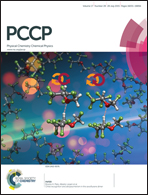From lime to silica and alumina: systematic modeling of cement clinkers using a general force-field†
Abstract
Thirteen different cement-clinker crystalline phases present in the lime–silica–alumina system have been systematically modeled using a simple and general force field. This constitutes a new type of approach towards the study of lime–silica–alumina systems, where the simpler and more transferable Lennard-Jones potential was used instead of the more traditional Buckingham potential. The results were validated using experimental density and structural data. The elastic properties were also considered. Six amorphous phases (corresponding to calcium/silicon ratios corresponding to belite, rankinite, wollastonite and alumina-doped amorphous wollastonite with 5%, 10% and 15% alumina content) were also studied using molecular dynamics simulations. The obtained MD trajectories were used to characterize the different crystalline and amorphous phases in terms of the corresponding radial distribution functions, aggregate analyses and connectivity among silica groups. These studies allowed a direct comparison between the crystalline and amorphous phases and revealed how the structure of the silica network was modified in the amorphous materials or by the inclusion of other structural units such as alumina. The knowledge at an atomistic level of such modifications is paramount for the formulation of new cement-clinker phases.


 Please wait while we load your content...
Please wait while we load your content...